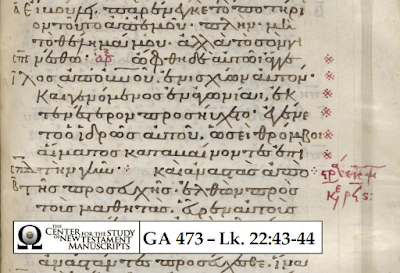GA 473 is the same manuscript that was known to F. H. A. Scrivener in 1853 as Lambeth Palace MS 1178 when he collated it (as Gospels-MS “d”) for his book about A Full and Exact Collation of About Twenty Greek Manuscripts of the Holy Gospels.
“It is one of the most splendid manuscripts extant,” Scrivener wrote about GA 473. He also mentioned that GA 473’s text “contains many remarkable variations, such as Scholz would refer to his Alexandrian recension.” Robert Waltz has briefly updated Scrivener, noting that GA 473 is part of von Soden’s “family IKC,” and thus an imperfect representative of Family Π, which constitutes, for the most part, the earliest stratum of the Byzantine Text of the Gospels.
Scrivener stated that Luke 22:43-44 is obelized, but the passage is accompanied by asterisks, not obeli, in the margin. And the manuscript features more than what Scrivener shared with his readers: in the margin of GA 473, alongside Luke 22:43-44, there is also a note referring to part a Maundy Thursday lection. (This lection begins in Matthew 26; jumps to John 13:1-17, jumps back to Matthew 26, and then jumps to Luke 22:43-44, and then jumps back to Matthew 26:40 (i.e., to Section 296 of Matthew). The hundreds-unit in the margin of GA 473 is an error; the expected hundreds-unit is 200 (ς) rather than 100 (ρ). Other than this misprint, or rather, miswriting, the marginalia in GA 473 shows how the text was used at Eastertime in the lectionary. (The asterisks need not convey scribal doubt.) (In the core members of family 13, Luke 22:43-44 is embedded within the text of Matthew, which is one of the strongest proofs of lectionary influence upon family 13’s text.)Scrivener listed 32 notable unusual readings attested by GA 473. Because he collated the entire text, there is no need to go through them all here, but a few may be pointed out as examples:
At Matthew 23:27, GA 473 reads
τοῖς ἀνθρώποις after φαίνονται, a reading shared by F and 33 (sorta).
At Mark 16:19, GA 473 reads ἐν
δεξια instead of ἐκ δεξιῶν, a reading shared by C and Δ.
At Luke 14:32, GA 473 reads εις before πρεσβείαν, yielding a minor tweak of the meaning.
At Luke 17:17, GA 473 reads ευκοποτερον (relieved) instead of the usual εκαθαρίσθησαν (cleansed). Perhaps an overly scrupulous scribe did not think that those who did not express thanks for the miraculous healing Jesus had given merited being called clean.
At John 2:14, GA 473 is missing the words καὶ περιστερὰς (and doves). This was very extremely probably due to simple parablepsis from the καὶ before περιστερὰς to the καὶ that comes after περιστερὰς.
At John 13:15, GA 473 reads ποιω instead of ἐποίησα.At John 19:21, GA 473 is missing the first occurrence of τῶν Ἰουδαίων. This is probably not accidental, but a case of stylistic adjustment to remove perceived superfluity.
Digital page-views of GA 473 at the CSNTM website have been fully indexed. Readers are invited to look over this manuscript for themselves to view its other interesting features (such as the obeli in the margin alongside John 5:4, as well as the readings within John 5:4 itself).


2 comments:
The different ink colour for the asterisks, and the formation of letters in red ink used for the κεφαλαια and τιτλοι, would indicate to me a different hand has added these, and they weren't the work of the original copyist. The obeli at John 5:4 could be the work of the original copyist; would need to check for some more which Scrivener may've missed/didn't mention.
Thanks for the reminder regarding this manuscript; the Wikipedia page on it required a decent edit. :)
Stewalch,
Scrivener noted back in 1853 that "Lk. xxi. 43, 44; Jn v. 4 are obelized in the margin; it is not easy to distinguish the changes introduced prima from those secunda manu."
JSJ
Post a Comment